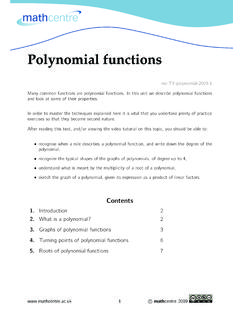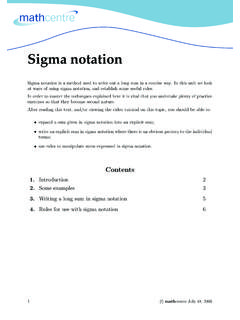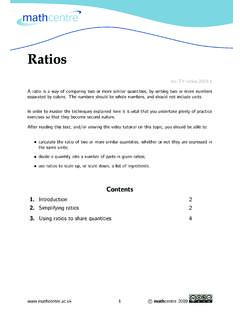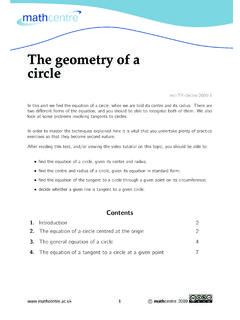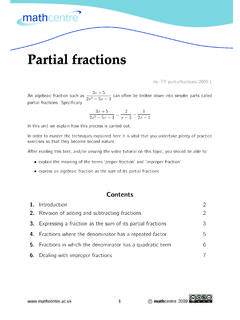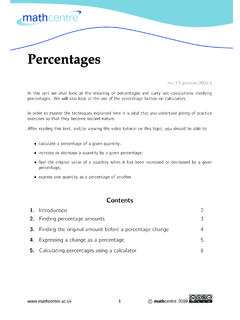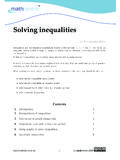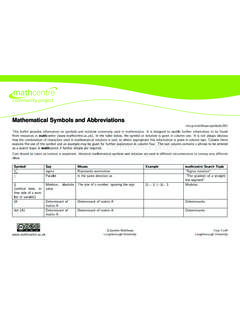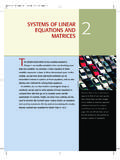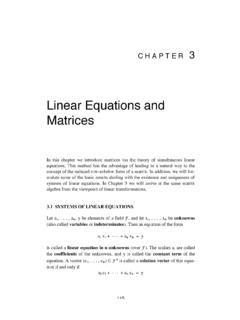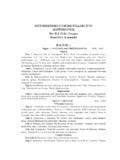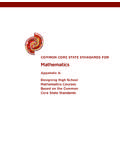Transcription of Simultaneous linear equations - Mathematics …
1 Simultaneous linearequationsThe purpose of this section is to look at the solution of Simultaneous linear equations . We willsee that solving a pair of Simultaneous equations is equivalent to finding the location of thepoint of intersection of two straight order to master the techniques explained here it is vital that you undertake plenty of practiceexercises so that all this becomes second nature. To help you to achieve this, the unit includesa number of such reading this text, and/or viewing the video tutorial on this topic, you should be able to: solve pairs of Simultaneous linear equations recognise that this is equivalent to finding the point of intersection of two straight Simultaneous equations - method of Simultaneous equations - method of mathcentreAugust7,20031.
2 IntroductionThe purpose of this section is to look at the solution of elementary Simultaneous linear we do that, let s just have a look at a relatively straightforward single equation. Theequation we are going to look at is2x y=3 This is a linear equation. It is a linear equation because there are no terms involvingx2,y2orx y, or indeed any higher powers ofxandy. The only terms we have got are terms inx, termsinyand some numbers. So this is can rearrange it so that we obtainyon its own on the left hand side. We can addyto eachside so that we get2x=3+yNow let s take 3 away from each 3=yThis gives us an expression fory: namelyy=2x we choose a value forx,sayx= 1, thenywill be equal to:y=2 1 3= 1 Suppose we choose a different value forx,sayx= 2 3=1 Supppose we choose another value forx,sayx= 0 3= 3 For every value ofxwe can generate a value can plot these as points on a graph.
3 We can plot the first as the point (1, 1). We can plotthe second one as the point (2,1), and the third one as the point (0, 3) and so on. Plottingthe points on a graph, as shown in Figure 1, we see that these three points lie on a straight is the line with equationy=2x 3. It is a straight line and this is another reason forcalling the equation 3 Figure 1. Graph ofy=2x mathcentreAugust7,20032 Suppose we take a second linear equation 3x+2y= 8 and plot its graph on the same figure. Aquick way to achieve this is as ,2y=8,soy= 4.
4 Therefore the point (0,4) lies on the ,3x=8,sox=83=223. Therefore the point (223,0) lies on the this is a linear equation we know its graph is a straight line, so we can obtain this byjoining up the points. Both straightline graphs are shown in Figure 3433x+2y=8 Figure 2. Graphs ofy=2x 3 and 3x+2y=8 When we solve a pair of Simultaneous equations what we are actually looking for is the intersec-tion of two straight lines because it is this point that satisfies both equations at the same Figure 2 we see that this occurs at the point wherex= 2 andy= course it could happen that we have two parallel lines; they would never meet, and hencethe Simultaneous equations would not have a solution.
5 We shall observe this behaviour in oneof the examples which PointWhen solving a pair of Simultaneous linear equations we are, in fact, finding a common point- the point of intersection of the two mathcentreAugust7,20032. Solving Simultaneous equations - method of substitutionHow can we handle the two equations algebraically so that we do not have to draw graphs? Weare going to look at two methods of solution. In this Section we will look at the first method -the method of us return to the two equations we met in Section y=3(1)3x+2y=8(2)By rearranging Equation (1) we findy=2x 3(3)We can now substitute this expression foryinto Equation (2).
6 3x+ 2(2x 3) = 83x+4x 6=87x 6=87x=14x=2 Finally, using Equation (3),y=2 2 3 = 1. Sox=2,y= 1 is the solution to the pair ofsimultaneous solution should always be checked by substituting back into both original equations toensure that the left- and right- hand sides are equal for these values ofxandy. So, withx=2,y= 1, the left-hand side of Equation (1) is 2(2) 1 = 3, which is the same as the right-handside. Withx=2,y= 1, the left-hand side of Equation (2) is 3(2)+2(1) = 8, which is the sameas the right-hand s have a look at another example using this particular example we are going to use is7x+2y=47(1)5x 4y=1(2)Now we need to make a choice.
7 We need to choose one of these two equations and re-arrange itto obtain an expression fory, or if we wish, forxThe choice is entirely ours and we have to make the choice based upon what we feel will bethe simplest. Looking at a pair of equations like this, it is often difficult to know which is mathcentreAugust7,20034 Let s choose Equation (2) and rearrange it to find an expression 4y=15x=1+4yby adding 4yto each sidex=1+4y5by dividing both sides by 5We now use this expression forxand substitute it in Equation (1).7 1+4y5 +2y=47 Now multiply throughout by 5.
8 Why? Because we want to get rid of the fraction and the wayto do that is to multiply everything by (1 + 4y)+10y= 235 Now we need to multiply out the brackets7+28y+10y= 235 Gather they s and subtract 7 from each side to get38y= 228 Soy=22838=6So we have established thaty= 6. Having done this we can substitute it back into the equationthat we first had +4y5=1+245and sox=5So again, we have our pair of values - our solution to the pair of Simultaneous equations . In orderto check that our solution is correct these values should be substituted into both equations toensure they balance.
9 So, withx=5,y= 6, the left-hand side of Equation (1) is 7(5)+2(6) = 47,which is the same as the right-hand side. Withx=5,y= 6, the left-hand side of Equation (2)is 5(5) 4(6) = 1, which is the same as the right-hand the following pairs of Simultaneous equations :a)y=2x+3y=5x 3b)y=3x 12x+4y=10c)6x+y=45x+2y=1d)x 3y=12x+5y=35e)2x+13y=13x+5y=6f)4x+3y=52x 34y=15c mathcentreAugust7,20033. Solving Simultaneous equations - method of eliminationWe illustrate the second method by solving the Simultaneous linear equations :7x+2y=47(1)5x 4y=1(2)We are going to multiply Equation (1) by 2 because this will make the magnitude of the coeffi-cients ofythe same in both equations .
10 Equation (1) becomes14x+4y=94(3)If we now add Equation (2) and Equation (3) we will find that the terms involvingydisappear:5x 4y=1+14x+4y=9419x=95and sox=9519=5 Now that we have a value forxwe can substitute this into Equation (2) in order to 4y=15 5 4y=125 = 4y+124 = 4yy=6 The solution isx=5,y= ExamplesSolve the Simultaneous equations3x+7y=27(1)5x+2y=16(2)We will multiply Equation (1) by 5 and Equation (2) by 3 because this will make the coefficientsofxin both equations the +35y= 135(3)15x+6y=48(4)If we now subtract Equation (4) from Equation (3)
